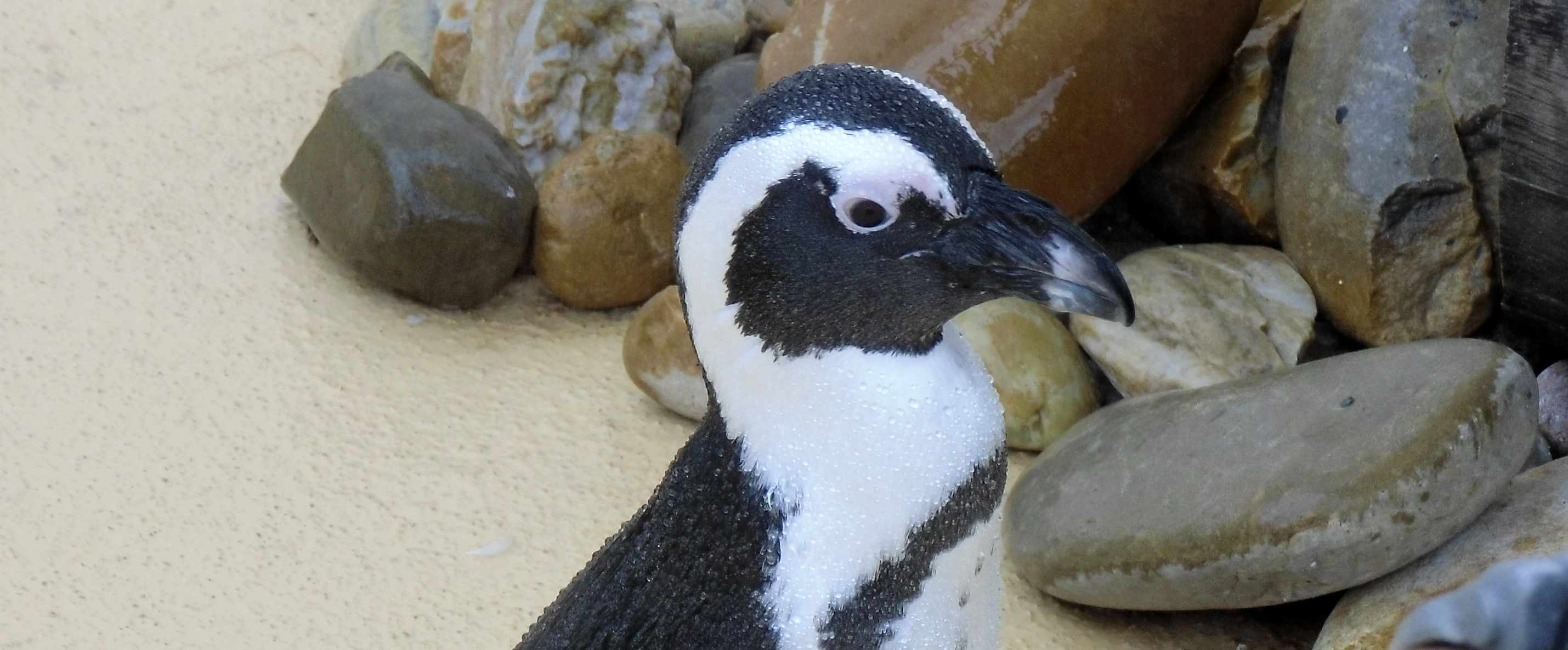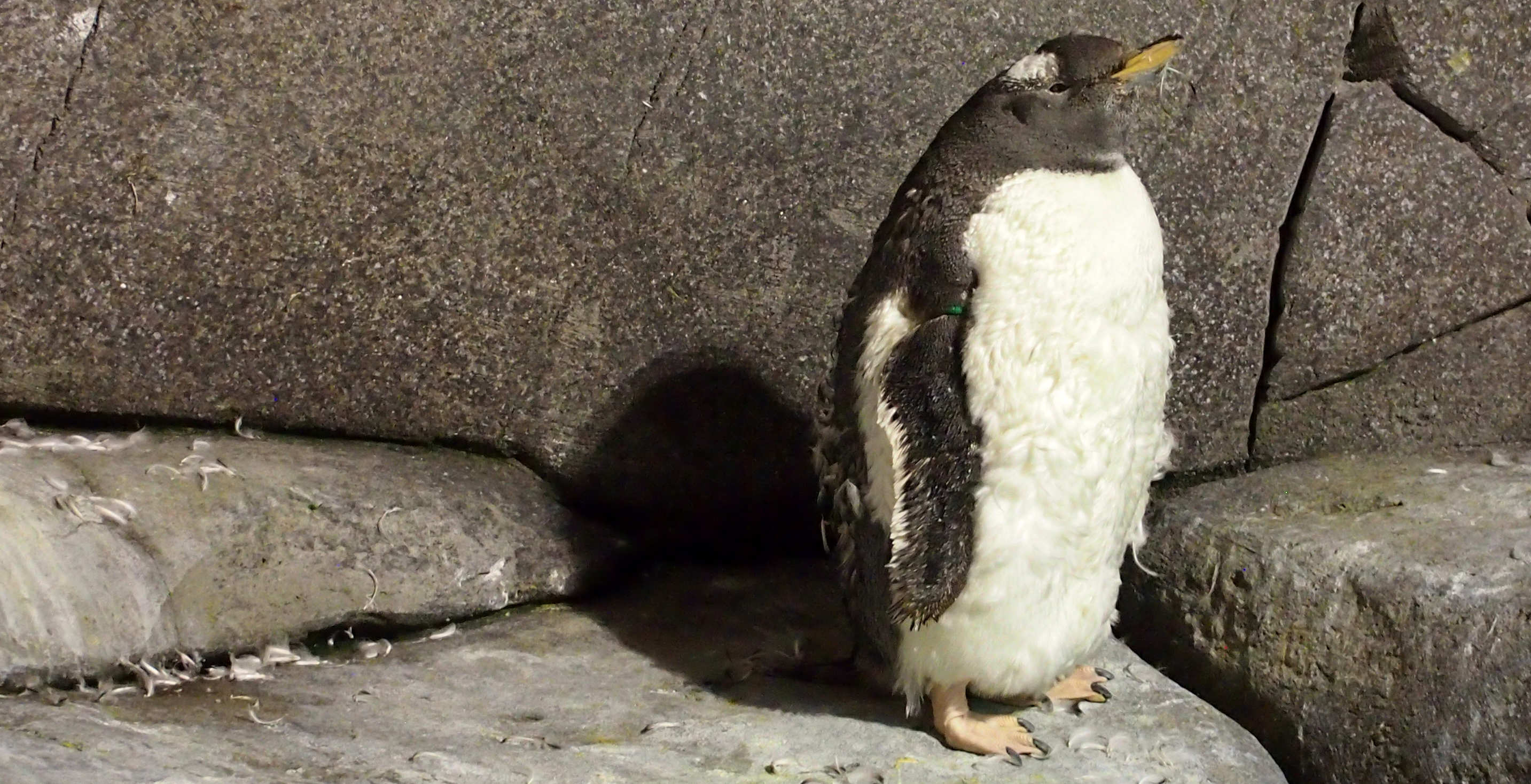
PinguinWissen.de – English
Feathering

African Penguin in Hanover Zoo, Germany: on this photo you can see how water drops roll off the penguin's feathering. (For an enlarged view please click on the photo.)
Many people think that penguins have a fur, but they are wrong. Penguins have feathers like all other birds, too. But it looks like fur because the feathers grow very densely. Emperor penguins have 12 feathers on each square centimeter of their body surface which length is four centimeter on average (Alfred-Wegener-Institute, Germany). All parts of the penguin's body is covered by feathers, except bill and feet. During incubation there is a small area on the penguins' belly with bare skin. In this area the eggs can be warmed up better with body heat.
The down feathers are the lowest layer of feathers. Downs are fluffy and bushy and between the feather branches air can be embedded. In case of a low surrounding temperature or in the cold water very less body heat gets lost because the air between the feather branches is a poor heat conductor. If it is very warm outside, there also will not get so much warmth into the body. So, the main function of the down feathers is the insulation.
The layer of down feathers is overlayed by the feather tips like roof tiles. These are oiled by the penguins frequently. They take oiled secretion of their preen glands (on the back, near the tip of the tail) with their beak and spread it on their feathers. This oil layer is very important because it is water-repellent and protects the feathers while swimming and diving. Otherwise the down feathers become wet and the insulation gets lost.

African Penguin in Hanover Zoo, Germany
Furthermore, preening is important to remove dirt and parasites.
The staining of the feathers is different on back and front. This is because of camouflage in the water. From the bottom the predators cannot differentiate between the white front of a penguin and the bright water surface. From the top the black back of the penguin looks like the dark ground of the sea. So, it is not easy for the predators to recognize penguins, this phenomenon is called countershading.
Molt

Molting Gentoo Penguin in Tierpark Hagenbeck, Hamburg, Germany
To remove old or broken feathers penguins have to molt frequently. In the most species molting takes place right after the last chick is reared in a breeding season. Chicks also have to molt to change their warming down feathers into waterproof feathers.
New feathers push the old ones out, that is why the penguins are looking very disheveled. During molt penguins cannot go swimming because there is no oil layer on their feathers and they would be subcooled in the water. That is why they have to gain weight before molt because they cannot feed during molt. After 4 to 5 weeks (it depends on the species) the molt is over and they can go foraging again.

African Penguin in Hanover Zoo pulls feathers with his beak.
References
Website of Alfred-Wegener-Institute: http://www.awi.de/de/entdecken/klicken_lernen/haeufige_fragen/pinguin/warum_frieren_pinguine_nicht/
Fowler, G. S., Fowler, M. E. (2001). Order Sphenisciformes (Penguins). Fowler ME, Cubas ZS. Biology, Medicine and Surgery of South American Wild Animals, 1, 53-64.
Kooyman, G. L., et al., Heat loss in penguins during immersion and compression, 1976. Comparative Biochemistry and Physiology Part A: Physiology 54.1, 75-80.
↑ back to top ↑
PinguinWissen.de
Further information
Last update: 19.01.2021
Currently under construction: Design and texts.
 GER
GER